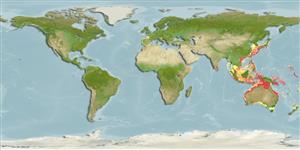Disteira major (Shaw, 1802)
Olive-headed seasnake| Native range | All suitable habitat | Point map | Year 2050 |

|
| This map was computer-generated and has not yet been reviewed. |
| Disteira major AquaMaps Data sources: GBIF OBIS |
Upload your photos
Google image |
No photo available for this species.No drawings available for Hydrophiidae.
Google image |
No photo available for this species.
Classification / Names Common names | Synonyms | CoL | ITIS | WoRMS
Reptilia | Squamata | Hydrophiidae
Environment: milieu / climate zone / depth range / distribution range Ecology
Demersal; depth range 7 - 100 m (Ref. 356). Tropical; 51°N - 58°S (Ref. 356)
Distribution Countries | FAO areas | Ecosystems | Occurrences | Introductions
Northeast Atlantic, the Mediterranean and Indo-West Pacific.
Length at first maturity / Size / Weight / Age
Maturity: Lm 71.0, range 62 - 143.1 cm Max length : 160 cm SVL male/unsexed; (Ref. 74665); common length : 120 cm SVL male/unsexed; (Ref. 2352)
Length from survey data of Australian Fisheries Research and Development Corporation (FRDC), Commonwealth Scientific and Industrial Research Organization (CSIRO) and fishers of Northern Prawn Fishery (Ref. 74665). Minimum depth from Ref. 102783. May be present and searching for muddy waters with prolific seaweeds. Feeds on small fishes captured near coral reef cavities (Ref. 2352).
Life cycle and mating behavior Maturity | Reproduction | Spawning | Eggs | Fecundity | Larvae
This species gives birth to 6 to 12 offspring.
Main reference
References | Coordinator | Collaborators
SAUP Database. 2006. (Ref. 356)
IUCN Red List Status (Ref. 130435)
Least Concern (LC) ; Date assessed: 15 February 2009
CITES status (Ref. 108899)
Not Evaluated
CMS (Ref. 116361)
Not Evaluated
Threat to humans
Human uses
| FishSource |
Tools
More information
Internet sources
BHL | BOLD Systems | CISTI | DiscoverLife | FAO(Publication : search) | Fishipedia | GenBank (genome, nucleotide) | GloBI | Gomexsi | Google Books | Google Scholar | Google | PubMed | Tree of Life | Wikipedia (Go, Search) | Zoological Record
Estimates based on models
Preferred temperature
(Ref. 115969): 14.7 - 28.1, mean 24.6 (based on 1014 cells).
Resilience
(Ref. 69278):
Medium, minimum population doubling time 1.4 - 4.4 years (K=0.23).
Price category
(Ref. 80766):
Unknown.


